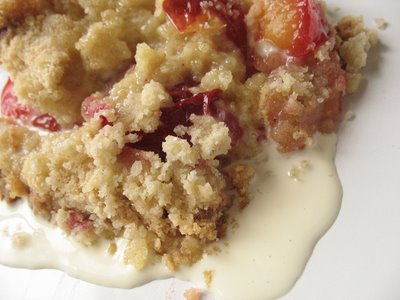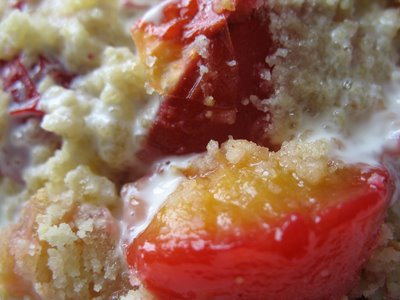Let's bake breakfast...
Sometimes when you are swept up in an urge to cook you spend the day embroiled in ingredients, being vaguely visible to others through a flurry of food.
Today I had such a day. It started when I woke up, determined to bake breakfast. There is something profoundly pleasurable about this activity - you wake up to a peaceful flat, and quietly work away undisturbed. Yet you are also graced with the knowledge that you aren't necessarily alone and that when everyone else wakes up, they'll do so to the smell of something delectable wafting under their bedroom door.
I'd had my eye on a recipe in Baking and the Art of Comfort Eating: Norwegian Cinnamon Rolls, which looked like perfect breakfast fare and had just the right amount of effort for a morning. Being a bread recipe it made it doubly cathartic too - it's clichéd, but there really is an inexplicable joy about the work that goes into things that need yeast. I've made muffins and such before for breakfast, but you just throw everything into a bowl and they aren't nearly as satisfying to make in comparison. There's a fantastically basic quality to bread and all the different stages it needs to go through that make it seem like a bona fide achievement, which is to me exactly how I want to feel at the start of my day.
Norwegian Cinnamon Buns from 'Baking and the Art of Comfort Eating' by Nigella Lawson (words by me)
For the dough:
- 600g strong plain flour
- 100g sugar
- 1/2 teaspoon salt
- 3 sachets/3 level tablespoons of easy-blend dried yeast
- 100g melted butter
- 400ml milk
- 2 free range eggs
for the filling:
- 150g softened, unsalted butter
- 150g sugar
- 1 1/2 teaspoons cinnamon
- 1 free range egg (for glazing)
Line a large, deep roasting tin or deep cake tin (roughly 33cm x 24cm) - round or square, doesn't matter - with baking parchment.
To begin making your dough, place all the dry ingredients in a capacious bowl. In another container, beat the eggs and milk together and then whisk in the melted butter. Pouring a steady stream, add the milk mixture to the flour and stir until combined. Bring the dough together with your hands and then turn out onto a lightly floured surface and knead until puffily elastic. Shape into a ball, and place in a lightly oiled bowl, cover with clingfilm and set it aside for 25 minutes somewhere warm-ish to let it prove and rise.
During that time, whip all the ingredients for the filling together in a small bowl. Once the dough has had its time, pull of a third and roll it out so it fits the base of your tin. Roll the rest out into a rectangle about 25cm x 50cm and then spread the cinnamon butter over, covering the surface's entirety. With the longest side facing you, roll the dough up as if you were forming a Swiss roll. You should end up with a long, thick cylinder. Cut this dough sausage into 2cm slices. You should end up with roughly 20 pieces. Places these rounds into your tin to cover the base (they may not fit together tightly but post-proving, they will). Slather the tops with the egg glaze and leave once more for 15 minutes. They will rise and swell and grow together. It's probably a good idea to put the oven on now to preheat, to 230C.
Once the swirls are sufficiently inflated, bake for 20-25 minutes until risen and golden. Let cool for 10 minutes, and then tear and share whilst warm.
Due to the quantities of the recipe making much more than Gareth or I could eat alone, I halved it. Or at least I thought I did. As I was adding the liquid ingredients to the dry, I noticed that the mixture was looking worryingly wet and I still had lots of it left. Looking back on the recipe I then realised that I put the stated two eggs in, instead of halving the quantity. After momentary annoyance, I figured it wouldn't be too much of a disaster, threw in a little more flour and hoped that the only difference would be a richer dough (which is by no means a catastrophe as far as I'm concerned).

The rest of the recipe went as planned, although after 10 minutes of baking it seemed that the bread does need to be in a deep tin as the gooey butter/sugar/cinnamon mix will ooze down the sides of the tin and gleefully spread itself all over the bottom of your oven. No matter though. The result was sticky, pillowy snails of richness (sounds odd but just go with it). The dough is akin to a brioche with a sugary crust and sinfully sweet cinnamon butter marbled through it. Its formed especially to break off individual rolls by hand. Definitely best carried ceremoniously back to bed whilst oven-warm and enjoyed with oversized mugs of coffee.

However, there was the small matter of the milk/egg/butter mix that was eyeing me from its jug. I couldn't face chucking it away; good free range eggs and butter and delicious organic milk do not deserve to end their life being poured into a kitchen sink. So, knowing that Gareth's brother was coming round the next day, and that I'd be cooking a dessert anyway, I decided to make a cake from it. I also had a bowl of cut orange segments (with peel) that no one was going to eat, but couldn't bear to dispose of so I thought about incorporating them in some way. My recipe follows as such but please, I urge you to double it for a result more substantial in size than mine - I was just using what I had.
For the Cake:
- 75g self raising flour
- 25g cocoa
- 90g butter
- 50g dark brown sugar
- 50g golden caster sugar
- 1 egg
- completely unmeasured egg/butter/milk mix (about 100ml of it)
For the Marmalade Syrup
- ½ an orange, with peel left on, cut into thin segments
- 2 tbsp of sugar
- 1 tbsp water
Cream the butter and sugars together until pale and fluffy. Beat in the egg and then the milk mix. Sift in the flour and cocoa powder and fold it carefully in. Bake in a small tin at 175C for around 15-20 mins or until the cake is risen and springs back when pressed.
Whilst the cake is in the oven, place the syrup ingredients in a pan, cover with a lid and bring to simmering point. Simmer until the orange peel is soft enough to bite into and then uncover to allow the syrup to reduce. I reckon if you have some orange liqueur to hand it wouldn't be a bad idea to slug some into the mix at this point. Actually, some Amaretto may also work in this syrup (based on my love of Amaretto and orange juice). If the liquid thickens too much, add a drop of water. It needs to be of a consistency that will allow the syrup to soak through the sponge.
Once the cake is cooked let it cool down a little (but not get cold as such) and turn it out onto a plate. What we are looking for here is moistness, so placing it onto a plate will allow less steam to evaporate from the cake and keep its crumb subtly damp. Using a thin sharp knife or a cake tester, prick holes all over the sponge and evenly pour the syrup over a little at a time (holding back the oranges with a spoon), allowing it to soak through before pouring on more. Once all the syrup has been absorbed, pile on the orange segments. This is excellent served with double cream - it soaks into the sponge and makes it a mile more luscious.
Note: There's nothing particularly innovative about the recipe but it makes a good basis for experimentation. If you were feeling particularly exploratory, you could add a scant amount of fresh red chilli strips to the syrup or you could play around with the cake mix and use polenta or ground almonds instead of flour. The whole idea as such begs to be meddled with - plain cakes with ginger and lime syrup or an amaretto syrup topped with toasted almonds. Frangelico syrup poured over an intense mocha sponge, topped with some chocolate covered espresso beans - the list goes as far as your own taste and imagination take you.
I digress. Still not tired from this I strode on to make a fabulous Steak and Guinness Pie as previously discussed. We didn't make the aforementioned pudding on account of the fact that waiting three hours for it would be kitchen overkill. However, we did bake the shortcrust pastry lid separate to the pie, which worked out much better than past attempts. A nice cold kitchen helped it remain really short and buttery too.
A mildly productive day then, I guess.
 Deciding that this is now a plus, I go on to slather the thing in buttercream and then as well as studding the circumference with maltesers, I fill the concave part with a mini pool of the little devils. It actually looks passable.
Deciding that this is now a plus, I go on to slather the thing in buttercream and then as well as studding the circumference with maltesers, I fill the concave part with a mini pool of the little devils. It actually looks passable.



